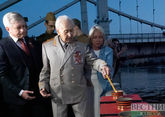Russia and Poland are remembering the Warsaw Uprising, which began on August 1, 1944 and ended on October 2 with the surrender of the rebels and the capitulation of the Home Army forces. The prevailing view in Poland now is that the Soviet leadership deliberately put on hold the advance of the Red Army, so that the Germans would deal with the initiators of the undesirable for the USSR uprising, who represented the Polish government's interests in London.
According to scientific director of the Russian Military-Historical Society Mikhail Myagkov, in 1943 they managed to agree with the Poles who remained in the Soviet Union to form the Polish division as part of the Red Army: "It was a division named after Tadeusz Kościuszko, which later grew into a corps, it was the first division formed of the Polish First Army. And then the Polish Second Army was formed. The military fraternity between the Soviet troops and the Polish armed forces in the German-Soviet War was also evident during both the liberation of Belarus and the Polish territory.
On July 21, 1944, the Polish Committee of National Liberation and an interim government were formed to assume power in the territories liberated by the Red Army. The territory liberated by the Red Army, the war zone was the military command's responsibility, and after redrawing the battle line farther West, the Poles themselves were to assume power. These agreements were reached.
But also there was the Polish government-in-exile, the so-called London Poles. In 1943, the following opinion was voiced at a meeting of the London government, and then by General Tadeusz Komorowski, who led the Home Army during World War II: "As long as Germany holds the Eastern Front and resists, this is beneficial, because the Germans are blocking the Red Army from the East, and the more they fight, the better. In the end, the Soviets will face off against the Anglo-Saxon powers, the anti-Hitler coalition will disintegrate, and Warsaw will gain its independence and borders, including those as of September 1, 1939." In the end, the Polish government-in-exile decided that it was necessary to seize power in Poland before the Red Army's rule, that is, the Soviet rule, was established there. Accordingly, it was necessary to start an uprising in Warsaw, gain control of the city before the Red Army could enter it, establish provisional authorities of the London émigré government there and present their demands to the Soviets : "We are an independent government, respect our authority."
Mikhail Myagkov said that a special bunker was equipped in Warsaw, which was protected by the Home Army units: "The Russians, in their opinion, should either obey the requirements of the London émigré government, or liquidate the Home Army. In any case, there should be an appeal directly to Churchill, the British and the Americans so that they helped the rebels seize power. That is, they counted on the international factor, on international resonance."
According to the historian, it cannot be called anything but an adventure: "The Red Army then travelled 500 km through the territory of Belarus. It was taking place against the backdrop of the uprising. Then the Poles tried to explain themselves, saying that there was allegedly a radio message from the Polish Tadeusz Kościuszko Infantry Division that they must start an uprising. But there was no such message. It was a made-up story, a lie spread by the Polish émigré government. Such a lie was, in fact, a betrayal of its own people, which was put under German fire. And there are so many similar lies on the part of the Polish government-in-exile and the Home Army."










